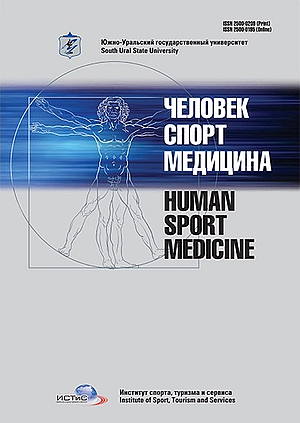TENDENCY OF CHANGES IN EXERCISE TOLERANCE IN HURDLERS AT DIFFERENT STAGES OF TRAINING AND COMPETITIVE CONDITIONING
Keywords:
Exercise tolerance, metabolic equivalent, anaerobic threshold, hurdlers, system of training and competitive conditioning.
Abstract
The aim of the research was to assess the influence of training factors at different stages of sport conditioning of hurdlers on their exercise tolerance. Material and Methods. 12 highlyskilled and elite hurdlers were recruited to participate in the research. Mean age of the volunteers was 22.8 ± 0.25. Exercise tolerance in the examined hurdlers at each stage of trainingcompetitive cycle was assessed via estimation of metabolic equivalent recorded with the help of ergospirometry (SHILLER CARDIOVIT АТ-104 PC Ergo-Spiro stress system) using 3-stage continuous cardiopulmonary exercise test. Load stages were adequate to periods of warming-up, stable functional state, and anaerobic threshold excess. Recovery time and baseline indicators at relative rest were also recorded. Results. Comparison of main stages of training and competitive conditioning in exercise tolerance revealed that activity of metabolic processes in hurdlers depended on the volume of specific muscle work in the zone of anaerobic-alactic energy supply. Conclusion. The research reveals the distinct correlation between exercise tolerance under increasing physical load and the character of structural-essential component of main stages of training and competitive conditioning in hurdling.References
1. Aksel'rod A.S. [Assessment of Stress Testing Results. Correct Answers to Basic Questions]. Kardiologiya i serdechno-sosudistaya khirurgiya [Cardiology and Cardiovascular Surgery], 2009, vol. 4, no. 5, pp. 46–49. (in Russ.)
2. Belotserkovskiy Z.B. Ergometricheskie i kardiologicheskie kriterii fizicheskoy rabotosposobnosti u sportsmenov [Ergometric and Cardiac Criteria for Physical Performance in Athletes]. Moscow, Soviet Sport Publ., 2005. 318 p.
3. Isaev A.P., Volchegorskiy I.A., Sashenkov S.L. [Problems and Adapt the Criteria for Athletes to Extreme Physical Stress in the Dynamics of Training-Competitive Cycle Training]. Teoriya i praktika fizicheskoy kul'tury [Theory and Practice of Physical Culture], 1995, no. 10, pp. 14–17. (in Russ.)
4. Mirzoev O.M., Avanesov V.U., Vrublevskiy E.P. Psikhofiziologicheskie i biokhimicheskie aspekty trenirovochnoy i sorevnovatel'noy deyatel'nosti legkoatletov. Puti povysheniya sportivnoy rabotosposobnosti sprinterov i bar'eristov: uchebno-metodicheskoe posobie [Psycho-Physiological and Biochemical Aspects of Training and Competitive Activities of Athletes. Ways to Improve Athletic Performance Sprinters and Hurdlers. Teaching Manual]. Moscow, 2007. 125 p.
5. Kharitonova L.G., Kuznetsova I.A. [Medical and Biological Control in the Sport at a Stage of Sports Perfection]. Teoriya i praktika fizicheskoy kul'tury [Theory and Practice of Physical Culture], 2015, no. 3, pp. 8–10. (in Russ.)
6. Chernyaev A.A. [Use of a Complex of Regenerative Means for the Functional State of the Musculoskeletal System in Training Bareristok Mesocycle]. Teoriya i praktika fizicheskoy kul'tury [Theory and Practice of Physical Culture], 2009, no. 11, pp. 33–38. (in Russ.)
7. Erlikh V.V., Isaev A.P. [Features of the Seasonal Rhythms of the Functional State and Sports Performance Athletes, Specializing in the Women's Middle Distance]. Teoriya i praktika fizicheskoy kul'tury [Theory and Practice of Physical Culture], 2015, no. 6, pp. 98–99. (in Russ.)
8. White T.L. Essentials of Hurdling. Athletic Journal, 1980, vol. 60, pp. 36–41.
2. Belotserkovskiy Z.B. Ergometricheskie i kardiologicheskie kriterii fizicheskoy rabotosposobnosti u sportsmenov [Ergometric and Cardiac Criteria for Physical Performance in Athletes]. Moscow, Soviet Sport Publ., 2005. 318 p.
3. Isaev A.P., Volchegorskiy I.A., Sashenkov S.L. [Problems and Adapt the Criteria for Athletes to Extreme Physical Stress in the Dynamics of Training-Competitive Cycle Training]. Teoriya i praktika fizicheskoy kul'tury [Theory and Practice of Physical Culture], 1995, no. 10, pp. 14–17. (in Russ.)
4. Mirzoev O.M., Avanesov V.U., Vrublevskiy E.P. Psikhofiziologicheskie i biokhimicheskie aspekty trenirovochnoy i sorevnovatel'noy deyatel'nosti legkoatletov. Puti povysheniya sportivnoy rabotosposobnosti sprinterov i bar'eristov: uchebno-metodicheskoe posobie [Psycho-Physiological and Biochemical Aspects of Training and Competitive Activities of Athletes. Ways to Improve Athletic Performance Sprinters and Hurdlers. Teaching Manual]. Moscow, 2007. 125 p.
5. Kharitonova L.G., Kuznetsova I.A. [Medical and Biological Control in the Sport at a Stage of Sports Perfection]. Teoriya i praktika fizicheskoy kul'tury [Theory and Practice of Physical Culture], 2015, no. 3, pp. 8–10. (in Russ.)
6. Chernyaev A.A. [Use of a Complex of Regenerative Means for the Functional State of the Musculoskeletal System in Training Bareristok Mesocycle]. Teoriya i praktika fizicheskoy kul'tury [Theory and Practice of Physical Culture], 2009, no. 11, pp. 33–38. (in Russ.)
7. Erlikh V.V., Isaev A.P. [Features of the Seasonal Rhythms of the Functional State and Sports Performance Athletes, Specializing in the Women's Middle Distance]. Teoriya i praktika fizicheskoy kul'tury [Theory and Practice of Physical Culture], 2015, no. 6, pp. 98–99. (in Russ.)
8. White T.L. Essentials of Hurdling. Athletic Journal, 1980, vol. 60, pp. 36–41.
References on translit
Published
2017-06-01
How to Cite
Semchenko, A., & Nenasheva, A. (2017). TENDENCY OF CHANGES IN EXERCISE TOLERANCE IN HURDLERS AT DIFFERENT STAGES OF TRAINING AND COMPETITIVE CONDITIONING. Human. Sport. Medicine, 17(2), 89-93. https://doi.org/10.14529/hsm170209
Issue
Section
Sports training
Copyright (c) 2019 Human. Sport. Medicine

This work is licensed under a Creative Commons Attribution-NonCommercial-NoDerivatives 4.0 International License.















